Let us take you to Greece, home of the ancient civilisation, beginning of democracy, laws and land of myths and legends. Here is our diary of adventures, explorations and travels.
Arriving in Athens one windy evening in May, we dumped our bags, found a lovely greek taverna near Technopolis called Sardelles (in the arty district!) and ate marinated octopus whilst enjoying the sounds of the jazz festival in the park opposite floating across to us.
Our airbnb apartment is tiny and our host is sleeping on her couch, but everything is so artistic, a bit run down and bohemian it is all forgiven. You can feel the art, culture music running through the streets.
Today we spent the day exploring the Acropolis with the Parthenon and various temples on the top of the ‘sacred rock’. The heat is intense. Then wandered down to the Parthenon museum which was fascinating. I finally got my Athenian history in order!
The Cretans and then Mycenaeans settled parts of Greece from the islands. From 1000BCE to 700 (slightly after Homer 800 BCE) the Ancient Greek civilisation blossomed.then Persians sacked Athens, the oracle told them to leave the city taking shelter in nearby city states. The rest of the Greek city states banded together to fight them off and won the naval Battle of Salamis in 480 pushing back the Persians. This caused the city states to form an alliance which would protect the seas, islands and cities. The Delian Naval league where everyone donated troops, ships or money. Athenian men made up most of it so they got money in return and that was the beginning of the Golden age for Athens.
Democracy, the Parthenon, new rebuilding of the acropolis, new agora, philosophers, were all wonderful developments in the golden age of Athens. But – the Delian League fell apart because rival city states felt it was unfair. Sparta objected and that led to the Peloponnesian wars. Sparta won, so they left the league, but other city states stayed for a while.
Then the Macedonians came in and sacked Athens, and other states. Romans to the rescue, Alexander the Great visited and made Athens (because of her fame) a roman centre of training, rich again with roman people, buildings, etc.
And that is most of the history in a jade nutshell.
After all that I need a drink, don’t you? Off we went to jazz fest, eating at the same restaurant Sardelles as it was so good. The house rose wine is delicious!
Today we went our separate ways – Greg wanted to see some art and I wanted to see the National Archeological Museum, and the rest of the ancient sites like the Agora and the legendary Amphitheatre of Dionysus.
First stop was the Kerameikos Cemetery, the original city cemetery. Its wonderful marble reliefs, stood on the beginning of the Sacred Way to Eleusis. The sun was relentless and there was little shade, I found myself wishing to the gods for a nice hat seller along the way to the Agora. As I took photos on the top of the Stoa of Attalos I noticed a stray white hat in the corner. No one nearby had lost it so I thanked the gods for my new hat!
|
|
|
Then saw the amazing Theatre of Dionysus, I gathered my courage and spoke a verse of Antigone, thinking of the amazing poets, plays and playwrights who eagerly awaited the verdict of a winning play!
Off to the amazing national museum of archeology!
From Cycladic art, to Mycenae, the Greek dark ages (1000bce- 700) the flourishing of Greek civilisation until the Persians, golden age, then Peloponnesian wars, Macedonians, Romans, Constantine and onwards…
So much amazing art, my feet were killing me no I was exhausted trying to see all the pots, frescoes, sculptures. In particular I loved The Charioteer, a bronze sculpture of young African boy riding a racing horse, an amazingly large mourning jar, and the wonderful 15th BCE sword handle in gold detail. The craftsmanship from so many centuries ago always blows my mind.
I met Greg and we walked to a cool arty area nearby where our friends had recommended the funky restaurant Giantes, for a yummy dinner, before collapsing in bed! 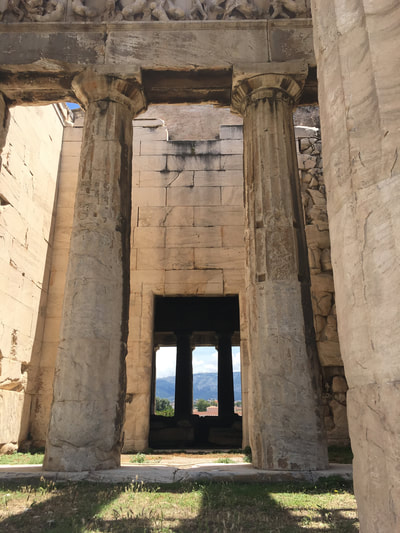
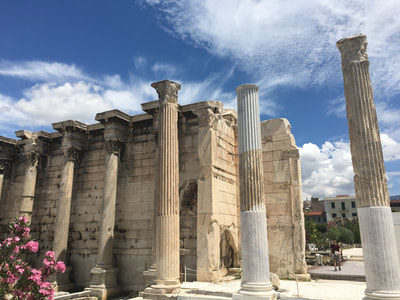
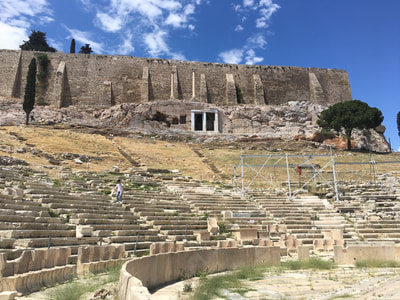
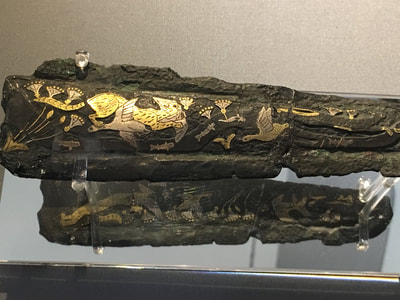
Let us take you to Greece, home of the ancient civilisation, beginning of democracy, laws and land of myths and legends. Here is our diary of adventures, explorations and travels.
Arriving in Athens one windy evening in May, we dumped our bags, found a lovely greek taverna near Technopolis called Sardelles (in the arty district!) and ate marinated octopus whilst enjoying the sounds of the jazz festival in the park opposite floating across to us.
Thursday – Our apt is tiny and our host is sleeping on her couch, but everything is so artistic, a bit run down but you can feel the art, culture music running through the streets. Today we spent the day exploring the Acropolis with the Parthenon and various temples on the top of the ‘sacred rock’. The heat is intense. Then wandered down to the Parthenon museum which was fascinating. I finally got my Athenian history in order!
Short History Lesson: The Cretans and then Mycenaeans settled parts of Greece from the islands. From 1000BCE to 700 (slightly after Homer 800 BCE) the Ancient Greek civilisation blossomed.then Persians sacked Athens, the oracle told them to leave the city taking shelter in nearby city states. The rest of the Greek city states banded together to fight them off and won the naval Battle of Salamis in 480 pushing back the Persians. This caused the city states to form an alliance which would protect the seas, islands and cities. The Delian Naval league where everyone donated troops, ships or money. Athenian men made up most of it so they got money in return and that was the beginning of the Golden age for Athens.
Democracy, the Parthenon, new rebuilding of the acropolis, new agora, philosophers, were all wonderful developments in the golden age of Athens. But – the Delian League fell apart because rival city states felt it was unfair. Sparta objected and that led to the Peloponnesian wars. Sparta won, so they left the league, but other city states stayed for a while.
Then the Macedonians came in and sacked Athens, and other states. Romans to the rescue, Alexander the Great visited and made Athens (because of her fame) a roman centre of training, rich again with roman people, buildings, etc.
And that is most of the history in a jade nutshell.
Then off to jazz fest, eating at the same restaurant Sardelles as it was so good. The house rose is delicious!
Friday
Today we went our separate ways – Greg wanted to see some art and I wanted to see the National Archeological Museum, and the rest of the ancient sites like the Agora and the legendary Amphitheatre of Dionysus.
First stop was the Kerameikos Cemetery, the original city cemetery. Its wonderful marble reliefs, stood on the beginning of the Sacred Way to Eleusis. The sun was relentless and there was little shade, I found myself wishing to the gods for a nice hat seller along the way to the Agora. As I took photos on the top of the Stoa of Attalos I noticed a stray white hat in the corner. No one nearby had lost it so I thanked the gods for my new hat!
|
|
|
Then saw the amazing Theatre of Dionysus, I gathered my courage and spoke a verse of Antigone, thinking of the amazing poets, plays and playwrights who eagerly awaited the verdict of a winning play!
Off to the amazing national museum of archeology!
From Cycladic art, to Mycenae, the Greek dark ages (1000bce- 700) the flourishing of Greek civilisation until the Persians, golden age, then Peloponnesian wars, Macedonians, Romans, Constantine and onwards…
So much amazing art, my feet were killing me no I was exhausted trying to see all the pots, frescoes, sculptures. In particular I loved The Charioteer, a bronze sculpture of young African boy riding a racing horse, an amazingly large mourning jar, and the wonderful 15th BCE sword handle in gold detail. The craftsmanship from so many centuries ago always blows my mind.
I met Greg and we walked to a cool arty area nearby where our friends had recommended the funky restaurant Giantes, for a yummy dinner, before collapsing in bed! 


 Suddenly it’s 2017 and I know I still need to finish the 2015 travels!
Suddenly it’s 2017 and I know I still need to finish the 2015 travels!
We were left in Bucharest and I have the rest of Romania (amazing place), Tuscany and Iceland to post.
But hopefully you’ll forgive me for skipping ahead to our recent trip to Athens & The Pelopponese May 2017.
So let me take you to Greece, home of the ancient civilisation, beginning of democracy, laws and land of myths and legends. Here is my diary of our adventures, explorations and travels.
Arriving in Athens one windy evening in May we dumped our bags, found a lovely greek taverna near Technopolis called Sardelles (in the arty district!) and ate marinated octopus whilst enjoying the sounds of the jazz festival in the park opposite floating across to us.
Thursday – Our apt is tiny and our host is sleeping on her couch, but everything is so artistic, a bit run down but you can feel the art, culture music running through the streets. Today we spent the day exploring the Acropolis with the Parthenon and various temples on the top of the ‘sacred rock’. The heat is intense. Then wandered down to the Parthenon museum which was fascinating. I finally got my Athenian history in order!
Short History Lesson: The Cretans and then Mycenaeans settled parts of Greece from the islands. From 1000BCE to 700 (slightly after Homer 800 BCE) the Ancient Greek civilisation blossomed.then Persians sacked Athens, the oracle told them to leave the city taking shelter in nearby city states. The rest of the Greek city states banded together to fight them off and won the naval Battle of Salamis in 480 pushing back the Persians. This caused the city states to form an alliance which would protect the seas, islands and cities. The Delian Naval league where everyone donated troops, ships or money. Athenian men made up most of it so they got money in return and that was the beginning of the Golden age for Athens.
Democracy, the Parthenon, new rebuilding of the acropolis, new agora, philosophers, were all wonderful developments in the golden age of Athens. But – the Delian League fell apart because rival city states felt it was unfair. Sparta objected and that led to the Peloponnesian wars. Sparta won, so they left the league, but other city states stayed for a while.
Then the Macedonians came in and sacked Athens, and other states. Romans to the rescue, Alexander the Great visited and made Athens (because of her fame) a roman centre of training, rich again with roman people, buildings, etc.
And that is most of the history in a jade nutshell.
Then off to jazz fest, eating at the same restaurant Sardelles as it was so good. The house rose is delicious!
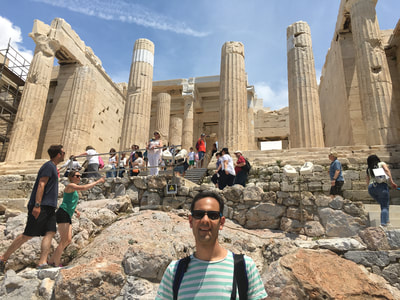

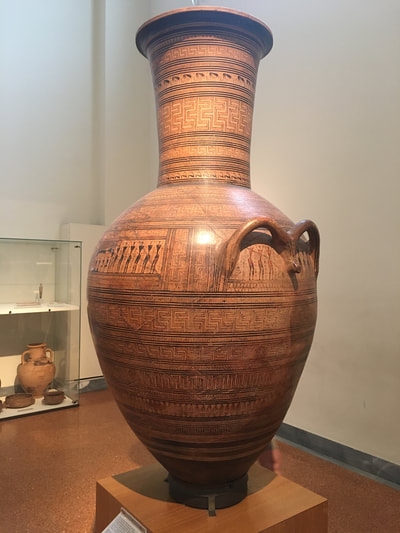
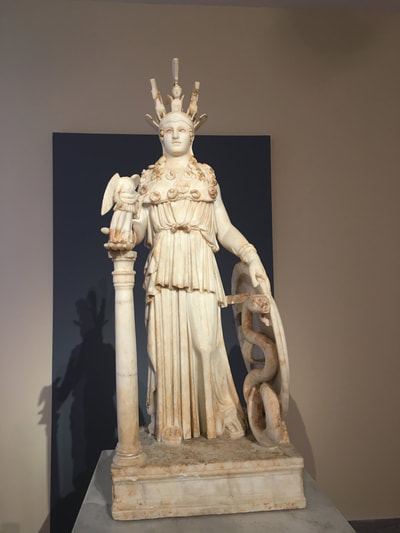
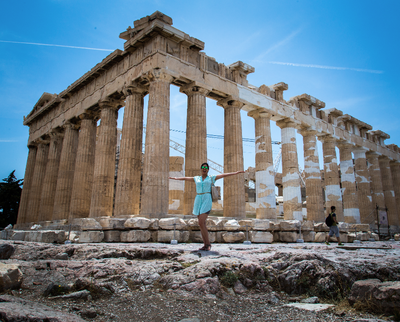
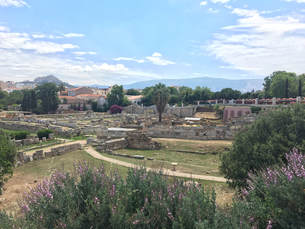
Friday
Today we went our separate ways – Greg wanted to see some art and I wanted to see the National Archeological Museum, and the rest of the ancient sites like the Agora and the legendary Amphitheatre of Dionysus.
First stop was the Kerameikos Cemetery, the original city cemetery. Its wonderful marble reliefs, stood on the beginning of the Sacred Way to Eleusis. The sun was relentless and there was little shade, I found myself wishing to the gods for a nice hat seller along the way to the Agora. As I took photos on the top of the Stoa of Attalos I noticed a stray white hat in the corner. No one nearby had lost it so I thanked the gods for my new hat!

|
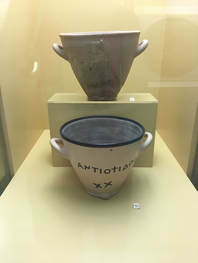
|
Then saw the amazing Theatre of Dionysus, I gathered my courage and spoke a verse of Antigone, thinking of the amazing poets, plays and playwrights who eagerly awaited the verdict of a winning play!
Off to the amazing national museum of archeology!
From Cycladic art, to Mycenae, the Greek dark ages (1000bce- 700) the flourishing of Greek civilisation until the Persians, golden age, then Peloponnesian wars, Macedonians, Romans, Constantine and onwards…
So much amazing art, my feet were killing me no I was exhausted trying to see all the pots, frescoes, sculptures. In particular I loved The Charioteer, a bronze sculpture of young African boy riding a racing horse, an amazingly large mourning jar, and the wonderful 15th BCE sword handle in gold detail. The craftsmanship from so many centuries ago always blows my mind.
I met Greg and we walked to a cool arty area nearby where our friends had recommended the funky restaurant Giantes, for a yummy dinner, before collapsing in bed!



